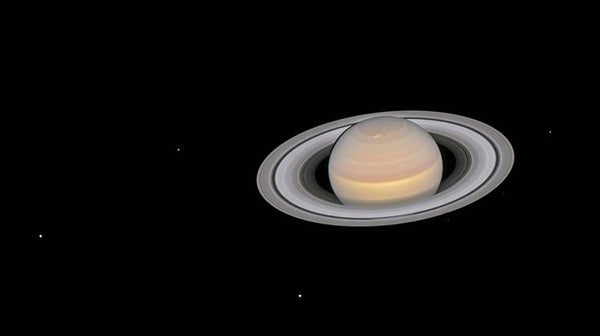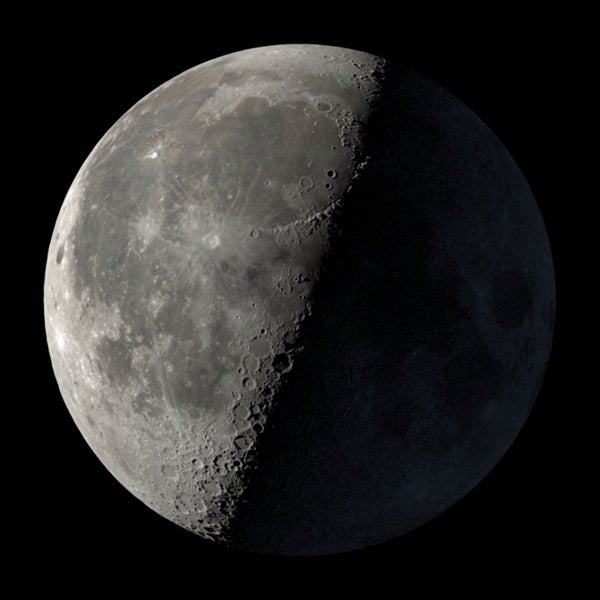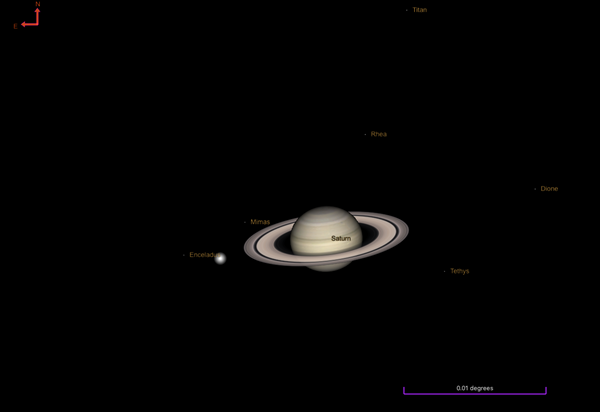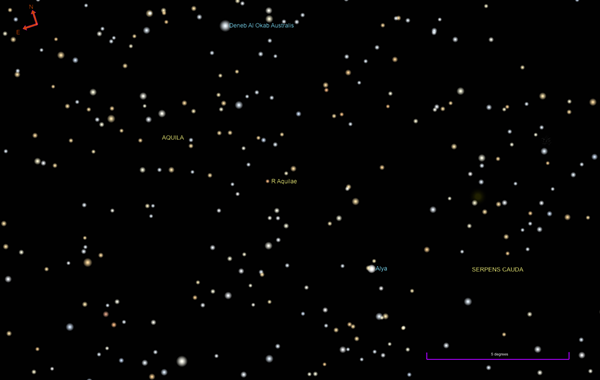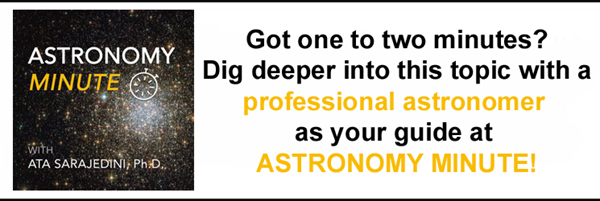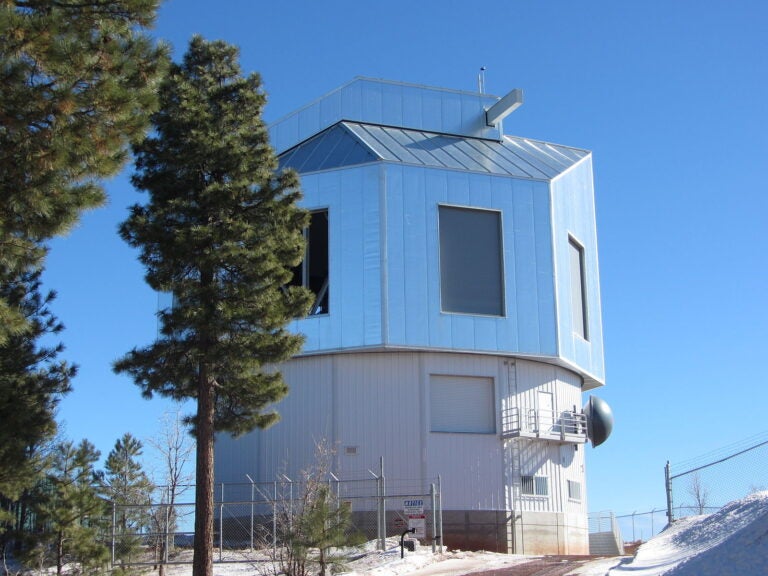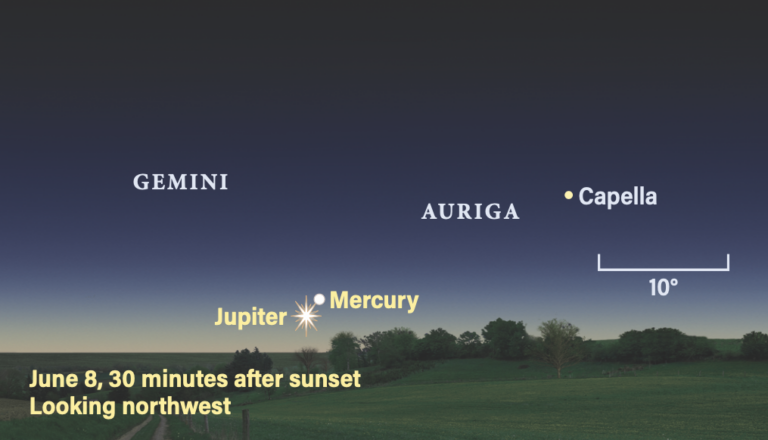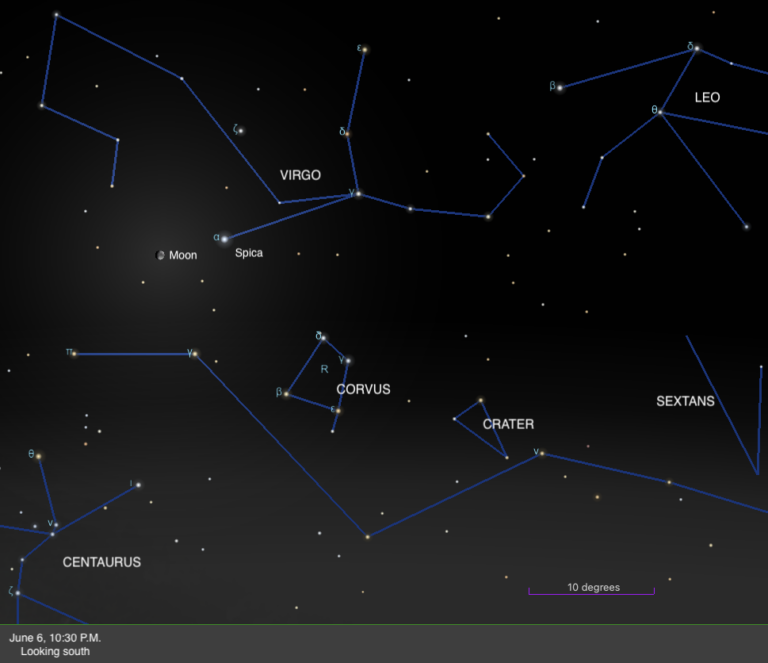Friday, July 30
Asteroid 4 Vesta skims less than 0.5° from the spiral galaxy NGC 4457 in Virgo today. Observers interested in catching the pair will need to be quick, however, as they’re already sinking low in the west as the sky grows dark and will disappear completely beneath the horizon by 11 P.M. local time. Even before then, your landscape or the turbulent air near the ground may hinder the view, so begin searching as soon as possible once twilight ends.
Vesta is a relatively easy magnitude 7.4, while its galactic “neighbor” is close to magnitude 11 and may appear only as a bit of fuzz. You’ll want to use a small telescope for the best view, especially if your skies suffer from light pollution. From a dark site, however, binoculars should net you at least the main-belt world.
If you’re looking for a galaxy that packs a bit more punch than NGC 4457, glance instead about 1.6° northwest of Vesta to snag 9th-magnitude M61, a brighter barred spiral.
Sunrise: 5:57 A.M.
Sunset: 8:15 P.M.
Moonrise: —
Moonset: 12:43 P.M.
Moon Phase: Waning gibbous (58%)
*Times for sunrise, sunset, moonrise, and moonset are given in local time from 40° N 90° W. The Moon’s illumination is given at 12 P.M. local time from the same location.
Saturday, July 31
Last Quarter Moon occurs at 9:16 A.M. EDT. This less-observed lunar phase is perfect for early risers and, if you’re willing to get out of bed to don binoculars or set up a telescope, you’ll be richly rewarded.
Appearing half illuminated with its right side lit (if you’re north of the equator), the Last Quarter Moon’s best feature is its terminator, where night meets day. Here, craters, mountains, and other features are thrown into sharp contrast. Some highlights include the lunar Apennine mountains and the craters Copernicus and Clavius. Zoom in with a telescope on the last target to find six smaller craterlets distributed in a stunning curve across its floor.
If you’re more of a night owl, the Moon passes 1.8° south of Uranus at 8 P.M. EDT. The magnitude 5.8 planet rises just after midnight in the constellation Aries, followed by Earth’s satellite about 20 minutes later.
Sunrise: 5:58 A.M.
Sunset: 8:14 P.M.
Moonrise: 12:02 A.M.
Moonset: 1:44 P.M.
Moon Phase: Waning crescent (49%)
Sunday, August 1
Mercury is in superior conjunction at 10 A.M. EDT, when it sits on the opposite side of the Sun as Earth and is hidden from view. Instead, let’s search out the other inferior planet: Venus, which dominates the western sky as an evening star throughout the month of August. Blazing at magnitude –3.9, you’ll find Venus 8° high in the west 45 minutes after the Sun sets. It appears roughly 14° below Denebola, which marks the tip Leo the Lion’s tail.
Much closer to the horizon, magnitude 1.8 Mars is 11° west of Venus and today sits 2° east of Regulus, Leo’s heart. If you’ve got time before it sets (around 9:20 P.M. local time), turn a telescope on Mars to view its 4″-wide disk. Then compare the sight to Venus, which appears 82 percent illuminated and 13″ across.
Sunrise: 5:59 A.M.
Sunset: 8:13 P.M.
Moonrise: 12:27 A.M.
Moonset: 2:44 P.M.
Moon Phase: Waning crescent (39%)
Monday, August 2
Today is a great day to view Saturn, which reaches opposition at 2 A.M. EDT. If you’re up early, the ringed planet won’t set until nearly sunrise; if you’re an evening observer, it will rise again as the Sun sets tonight and climb to 15° in altitude by 10 P.M. local time.
The planet, which glows near magnitude 0 all month, is in Capricornus the Sea Goat, nearly even in altitude with much dimmer magnitude 4 Theta (θ) Capricorni. Any telescope will show the gas giant’s 19″-wide disk and stunning ring system, which stretches 42″ across. Thanks to the planet’s roughly 18° tilt to our line of sight, its south polar region is visible. Cloud features are typically more difficult to make out on Saturn than on larger, closer Jupiter, but patient observers with steady seeing may be rewarded.
While you’re zoomed in on the planet, look 36″ east to find magnitude 12 Enceladus, one of the planet’s moons. Between the planet and its moon tonight, however, just 27″ from the center of Saturn’s disk, is an interloper: a star with nearly the same magnitude 12 brightness as the moon.
Earth’s Moon reaches apogee, the farthest point from our planet in its orbit, at 3:35 A.M. EDT. It will then sit 251,289 miles (404,410 kilometers) away.
Sunrise: 6:00 A.M.
Sunset: 8:12 P.M.
Moonrise: 12:56 A.M.
Moonset: 3:44 P.M.
Moon Phase: Waning crescent (30%)
Tuesday, August 3
Sitting in the south this evening is an asterism, or unofficial grouping of stars, that’s easy to recognize. The Teapot in Sagittarius is formed by eight stars: Zeta (ζ), Tau (τ), Sigma (σ), Phi (ϕ), Lambda (λ), Delta (δ), Gamma (γ), and Epsilon (ϵ) Sagittarii. As its name implies, this asterism looks like a teapot with its handle to the east and its spout to the west. It’s sitting upright as it rises and will tip toward its spout overnight, setting with its handle up and its spout disappearing first.
At the top of the triangular lid is Lambda, while Gamma forms the tip of its spout. Sigma, which joins the top of the handle with the Teapot’s body, is also known as Nunki. It is the constellation’s second-brightest star; Epsilon, at the lower right-hand corner of the Teapot’s body and also called Kaus Australis, is Sagittarius’ brightest star.
Sunrise: 6:01 A.M.
Sunset: 8:11 P.M.
Moonrise: 1:29 A.M.
Moonset: 4:43 P.M.
Moon Phase: Waning crescent (22%)
Wednesday, August 4
Asteroid 3 Juno is stationary at midnight EDT. Juno was the third asteroid ever discovered and is the 10th-largest asteroid, with a span of about 145 miles (234 km) across. Currently in the constellation Ophiuchus, Juno sits slightly above the halfway point on a line drawn between Zeta and Delta Ophiuchi. Roughly magnitude 10, you’ll need binoculars or a small scope to spot the main-belt world. Tonight, it’s also just 10′ from an 8th-magnitude field star (HIP 81153).
While you’re in Ophiuchus, this large constellation is home to several relatively bright globular clusters as well. Less than 6° northeast of Juno’s position are M10 and M12, which sit just 3.3° apart (M12 is northwest of M10). Instead, if you drop about 6.8° south-southwest of Juno’s position, you’ll run smack dab into M107.
Sunrise: 6:01 A.M.
Sunset: 8:10 P.M.
Moonrise: 2:07 A.M.
Moonset: 5:41 P.M.
Moon Phase: Waning crescent (15%)
Thursday, August 5
Now that August is here, the American Association of Variable Star Observers (AAVSO) is featuring a new monthly variable star: R Aquilae. This star is a Mira-type variable, named for that star in Cetus the Whale. These variables are aging stars known as red giants, which are cooler, puffed-up versions of their younger selves that appear visibly orange or red.
R Aquilae sits about 5.6° south of Deneb Al Okab Australis (Zeta Aquilae) and 4.7° northeast of Alya (Theta Serpentis) in Serpens Cauda. Discovered as a variable in 1856, R Aquilae’s period, or the time between a full cycle from bright to dim to bright again, has been decreasing over time. Its period is currently about 270 days, down from more than 300 days when it was first discovered. R Aquilae bounces between magnitude 5.5 (visible to the naked eye for those with good vision under dark skies) and magnitude 12, which cannot be seen without optical aid.
Want to learn in more detail how to make your own light curves for submission to the AAVSO? Astronomy has you covered — check out our article on how to estimate a variable star’s current brightness.
Sunrise: 6:02 A.M.
Sunset: 8:09 P.M.
Moonrise: 2:53 A.M.
Moonset: 6:34 P.M.
Moon Phase: Waning crescent (8%)
Friday, August 6
Although the Southern Delta Aquariid meteor shower peaked last Friday, the Moon is now much more favorable for spotting meteors streaking away from its radiant in Aquarius. The Water-bearer sits in the southern sky early this morning, and the shower’s radiant is just 2.5° southeast (to the lower left) of bright Jupiter.
Plus, the Perseid meteor shower, which peaks next week under favorable conditions —so stay tuned! — is now ramping up with a radiant in the eastern sky. That radiant sits 2.5° northeast of magnitude 3.8 Miram.
With the Southern Delta Aquariids waning and the Perseids still gaining momentum, the sky won’t exactly be filled with meteors. But chances are still high you may catch an errant bright streak from one of these showers. To maximize the chances of catching one, start looking about two hours before sunrise (around 4 A.M. local time) from a location with as little artificial light pollution as possible. Turn your gaze in a direction about 40° to 60 ° away from either radiant — this is where the brightest meteors typically occur.
Sunrise: 6:03 A.M.
Sunset: 8:08 P.M.
Moonrise: 3:47 A.M.
Moonset: 7:23 P.M.
Moon Phase: Waning crescent (4%)

